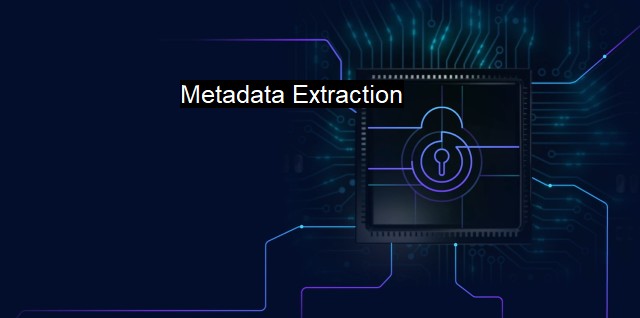What is Metadata Extraction?
Unlocking Cybersecurity through Metadata Extraction: Protecting Sensitive Data in Today's Digital Age
Metadata extraction is a crucial process in comprehensive cyber threat analysis that allows cybersecurity experts to understand and analyze malicious content better and try to develop protective measures against it. While the term may be a bit jargon-heavy, it essentially refers to obtaining key indexing information—metadata—from a file, data array, or data stream, which can then be utilized to classify, sort, or manage that data, both in terms of online and digital contexts.In the realm of cybersecurity and antivirus operation, the metadata extracted often pertains to data about other data. This meta-information often includes the size of a file, the date and time of its creation, or the author of a document. More sophisticated metadata might also contain data summaries or keywords, content ratings, location coordinates, or system file identification labels.
So how exactly does metadata extraction fit into the cybersecurity scheme? metadata extraction is a tool for understanding the content, context, and trends within large volumes of data—data that can expose insights about potentially malicious threats. For instance, a cybersecurity system monitoring network traffic might pinpoint a seemingly innocuous series of file exchanges. Still, by extracting and analyzing the metadata from these files—such as determining their origin, file type, and transit patterns—it may reveal connections to known malicious sources, or patterns of covert cyber warfare behavior.
For antivirus operations, metadata extraction can specifically identify electronic threats. Antivirus software traditionally works by scanning files and checking their contents against a database of known threats—a practical yet profoundly reactive method that leaves devices vulnerable until the maker of the antivirus software formally identifies, catalogs, and come up with an antidote for the threat. combined with metadata extraction, the process can utilize information such as the origin of a file; suddenly, files from less credible sources can be treated with higher suspicion even without a confirmed threat.
Still further, malware often attempts to conceal its true intent, surreptitiously piggybacking on legitimate-looking files or communicating quietly in the background. Utilizing metadata extraction, cybersecurity systems can look deeper into these kinds of behaviors, bisecting, classifying, and linking seemingly subtly sinister file origins or transactions, and help to reveal these concealed threats.
While metadata extraction is a key tool in combating cybersecurity threats, it doesn't come without its challenges. Large volumes of data often come encrypted, or the metadata may be pertinent in a language foreign to the investigators. In such cases, advanced metadata extraction tools are required. a challenge for many cybersecurity teams is the overwhelming volume of data they face daily—sifting through, tracking, and extracting metadata from millions of communications can be daunting.
Amid all the difficulties, the value of metadata extraction remains immense in the context of cybersecurity. Beyond merely assessing the nature and potential threat of a suspicious file, the practice lays bare a swath of more holistic data-inspired relationships, such as correlating different malicious files or unriddling patterns in cyberattack operations—ultimately sketching a broader picture of cybersecurity threats.
We can define metadata extraction as the backbone process of cyber threat analysis that involves interpreting, classifying, and managing data to identify potential threats. The extraction process helps cybersecurity and antivirus operations understand the content within vast volumes of data, giving them an upper hand in combating cyber threats and ensuring secure data handling. professionals must stay up-to-date with the latest tools and adapt accordingly to meet complex extraction challenges due to encryption measures or sheer data volume. A blend of efficient metadata extraction tools and advanced skills can definitely shape up a robust cybersecurity framework.

Metadata Extraction FAQs
What is metadata extraction?
Metadata extraction is the process of extracting information from digital files such as documents, images, or audio and video files. It involves the collection of data such as file name, author name, creation date, and other details that are embedded within the file.Why is metadata extraction important in cybersecurity?
Metadata extraction is important in cybersecurity because it helps security professionals identify potential security threats and prevent attacks. Metadata can reveal details about the source and origin of digital files, which can be used to identify malicious actors or detect anomalies in network traffic.How does antivirus software use metadata extraction?
Antivirus software uses metadata extraction to scan digital files for potential security threats. The software analyzes the metadata embedded in the file, such as file type, size, and creation date, to determine whether the file is potentially harmful. It can also use metadata to identify the source of the file and block incoming threats.What are some challenges of metadata extraction in cybersecurity?
Metadata extraction in cybersecurity can be challenging due to the large volume of data involved, as well as the complexity of digital file formats. Some file formats may not include metadata, and some metadata may be intentionally altered or obscured to evade detection. Additionally, metadata extraction can raise privacy concerns, since it may involve the collection of personal information.| | A | | | B | | | C | | | D | | | E | | | F | | | G | | | H | | | I | | | J | | | K | | | L | | | M | |
| | N | | | O | | | P | | | Q | | | R | | | S | | | T | | | U | | | V | | | W | | | X | | | Y | | | Z | |
| | 1 | | | 2 | | | 3 | | | 4 | | | 7 | | | 8 | | |||||||